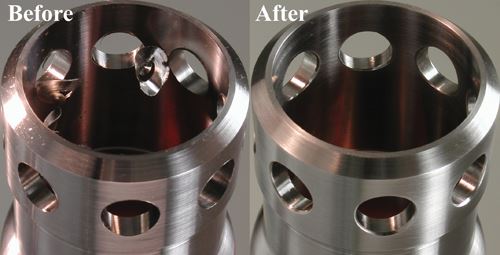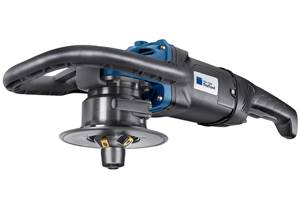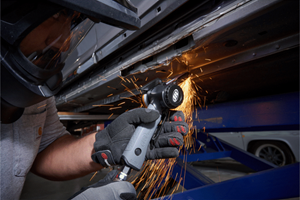The varied list of applications and industries that have employed the Flex-Hone suggests this bore-finishing tool was aptly named. According to manufacturer Brush Research Manufacturing (Los Angeles, California), the ball-style hone has been used by injection molders to maintain extruder barrels, by EDM shops to clean nozzle orifices, by automotive rebuilders to deglaze cylinder walls, and by countless other manufacturers serving a variety of industries. It also has been employed for a range of servicing applications in the field, from maintaining large pumps and valves to repairing aircraft fastener holes and even servicing engine components in oceangoing vessels.
The company offers two examples to showcase how the tool can help meet needs for exacting surface finish requirements, both in the shop and in the field. The first describes a process that uses the Flex-Hone and tools from another manufacturer to create precise, smooth through-holes in hardened materials. The second details a workholding supplier’s efforts to help a customer in China conduct emergency repairs on critical cylinder components.
When an application requires assembling components together, ensuring a proper, lasting fit often requires ridding fastener through-holes of burrs and other imperfections. This can be challenging with hardened materials like nickel, Inconel, Waspaloy, titanium and stainless steel. Gary Brown, vice president and general manager of Heule Tool Corporation (Cincinnati, Ohio), says the Flex-Hone is a critical part of a process for such work that is catching on among the cutting tool supplier’s customers in the aerospace, automotive, semiconductor and medical sectors.
This automated process involves a combination of the Flex-Hone and two offerings from Heule: the DEFA precision chamfering tool and COFA universal deburring tool. “Our tool cuts through the metal and puts the beveled edges on the front and back of the metal part,” Mr. Brown explains. “It also removes the drill burrs and drill caps created by the drill, reamer or end mill. Our tools also perform the edge-breaking step. However, we also recommend going in with the Flex-Hone to round the transition between the beveled edge and the hole.”
According to Brush Research Manufacturing, the Flex-Hone could be applied effectively for similar applications in virtually any metal because it can be custom-designed to fit the requirements of the job. Consisting of an array of abrasive globules suspended by flexible filaments along a central shaft, the tool is available in 11 different grit selections and eight different abrasive types, which range from aluminum oxide for soft materials to diamond for hardened tool steels and ceramics. Sizes range from 4 mm in diameter to 36 inches in diameter.
Like Heule Tool, workholding supplier Vektek (Saint Joseph, Missouri) also recommends the Flex-Hone to customers. In these cases, the tool is used to properly prepare fixture cavities that accept cylinders for the company’s hydraulic and pneumatic clamping systems. Any finishing imperfections, even minute scratches, can cause the cylinders to leak. Such leaks can often cause the cylinders to fail and lose their grip on the workpiece, necessitating a halt in production, the company says.
In one recent case, the Flex-Hone was used to rehabilitate 300 of these fixture cavities that had been poorly machined by a heavy equipment manufacturer in China. Although the problem was no fault of the Vektek cylinders’ design or quality, the issue had to be addressed at the customer’s site or the expensive fixtures would not be usable.
The company advised technicians at the Chinese manufacturing plant on using the Flex-Hone to properly finish the cylinder cavities and eliminate the sealing problem. “These cylinders require a very good seal—very accurate, very round, and with a high-quality finish,” says Rob Nelson, vice president of Vektek International Sales. “The Flex-Hone is self-centering, so it is easy to get a uniform hole finish because it always exerts the same pressure on all sides.”
The ability to mount the tool in a handheld drill motor, as opposed to a CNC machine or other such equipment, also proved useful for this field application. In all, the customer Flex-Honed 300 cavities, of which 299 were saved and polished exactly to specification. “One cavity was slightly out of spec, but it also provided an adequate seal,” Mr. Nelson says. “So, in the end, we saved 300 very expensive holes.”





















.png;maxWidth=300;quality=90)








.jpg;maxWidth=300;quality=90)







